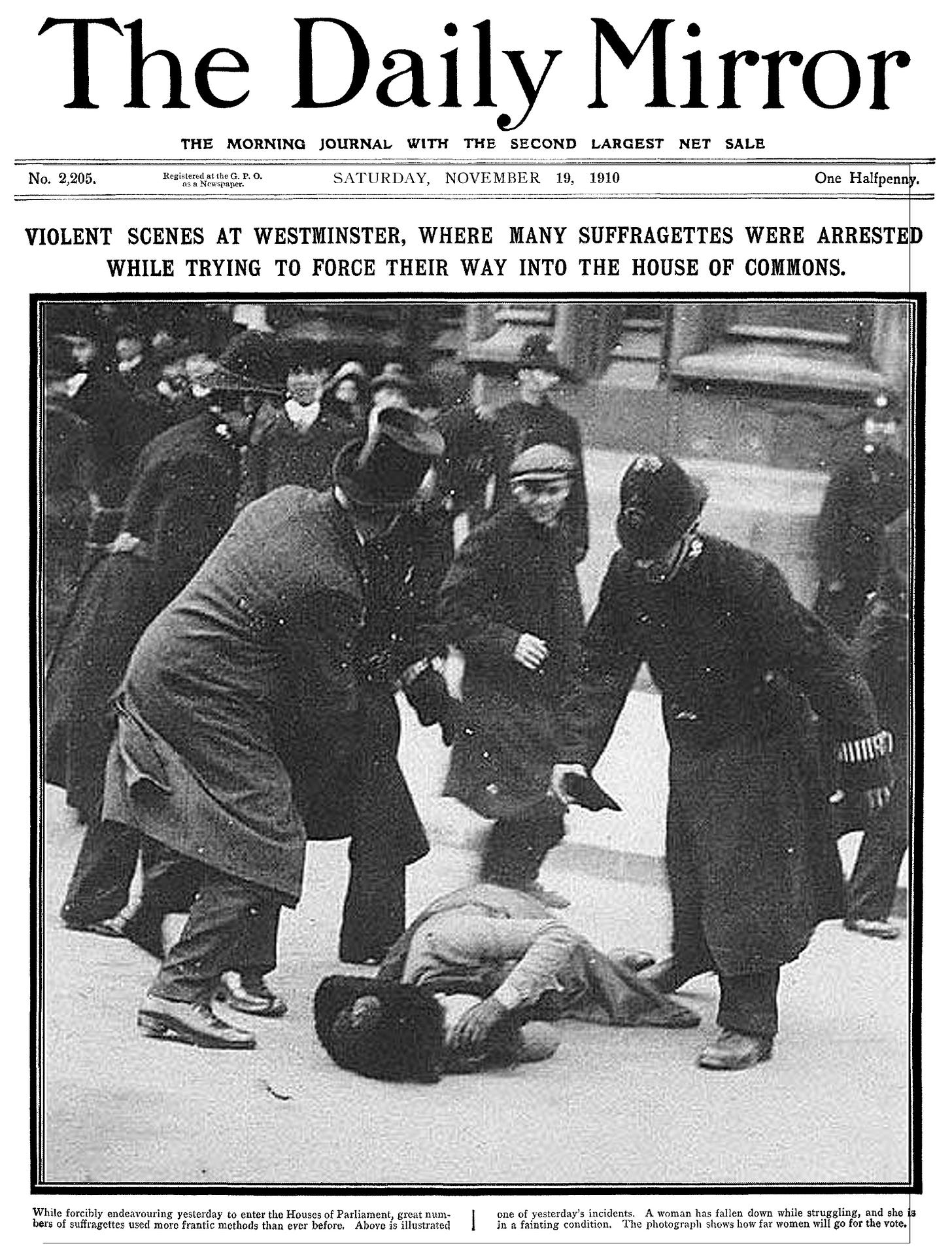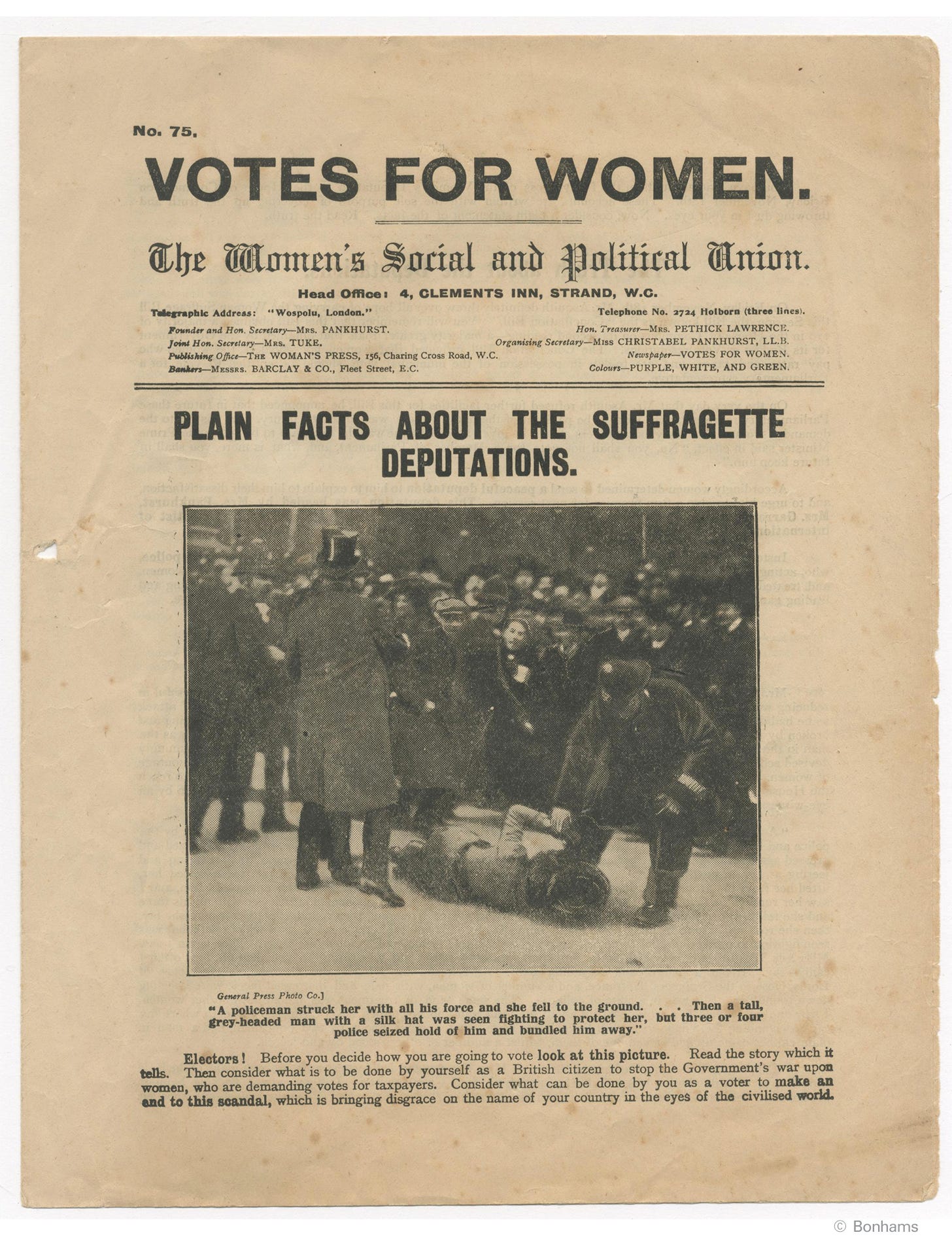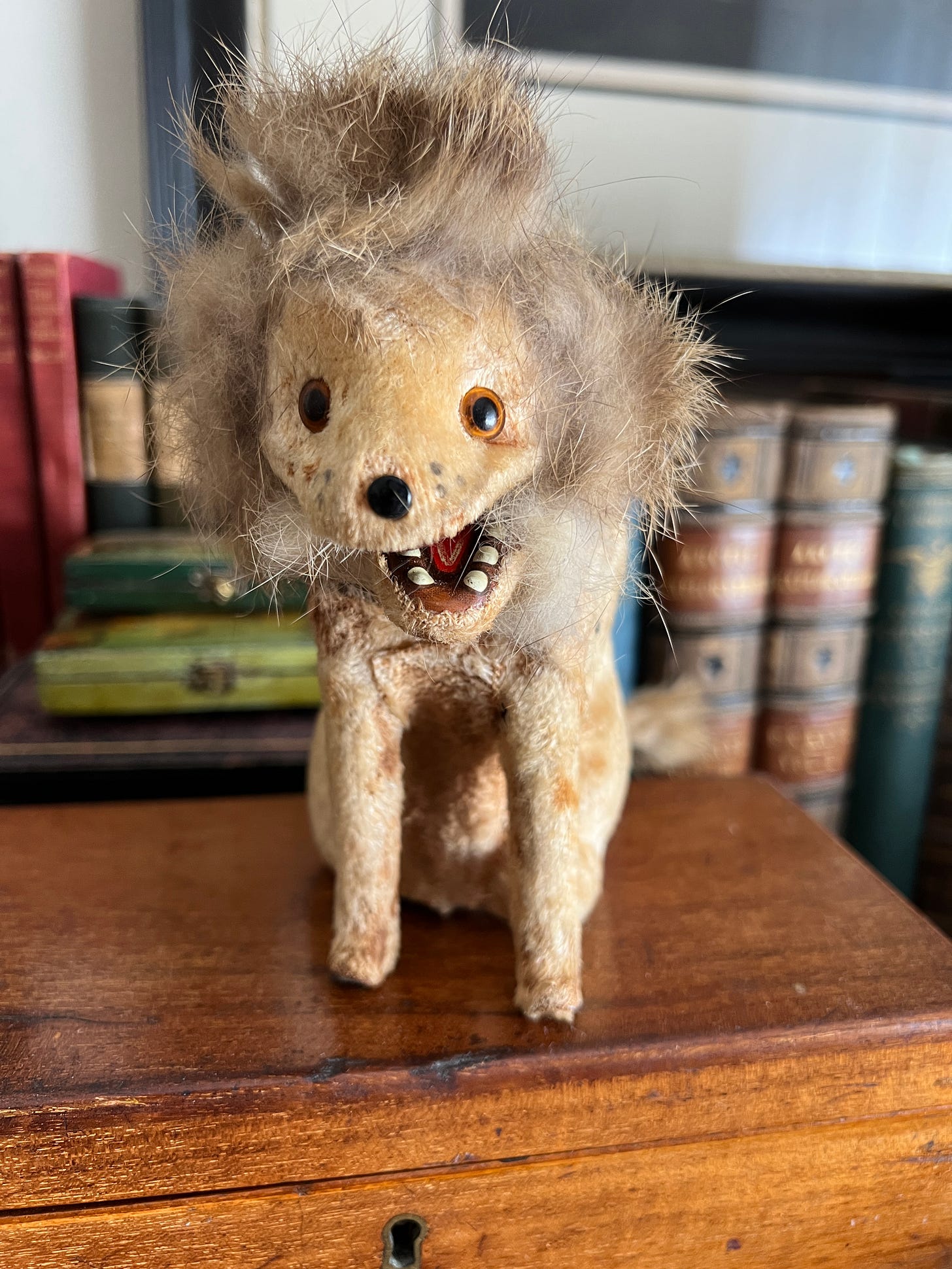A hunger striker's medal, a Danish love token, and Hello Kitty
Scroll to the end to see what I bought last weekend
Hello, everyone! It’s been a while, as I’m having a difficult time balancing…….life, basically. I also haven’t been super inspired by many of the auctions I’ve been perusing, but thankfully Bonhams have come through with an extraordinary piece of history that I’d like to highlight for you.
The medal above was awarded to suffragette Ada Wright (1861-1939) by the English women’s suffrage organization The Women’s Social and Political Union (WSPU), in recognition of her efforts in the campaign to grant women the right to vote. It’s being sold in the Fine Books and Manuscripts auction at Bonhams London on March 29.
Ada Wright was a longtime campaigner for women’s suffrage and a close friend of Emmeline Pankhurst, the founder of the WSPU, as well as her daughters Christabel and Sylvia (also leaders of the movement).
Wright was a small, slight woman who was tireless in her work for the campaign, contributing both funds and action. Diane Atkinson’s excellent book Rise Up Women! The Remarkable Lives of the Suffragettes states that she was “one of those quiet women whose gentle and calm manner hides a courageous and indomitable nature of unexpected depths,” and she did not shy away from violence in pursuit of the cause.
The WSPU’s motto was “deeds, not words,” and in addition to organizing rallies and protesting outside Parliament, they also advocated more aggressive means of demonstration. Members smashed windows, set buildings on fire, and assaulted the police — sometimes in a deliberate effort to be arrested and therefore gain more publicity. When incarcerated, the women often went on hunger strikes and were brutally force fed.
Wright is the woman pictured in one of the most iconic images of the English suffrage movement:
On November 18, 1910, following a political decision that was seen as a betrayal of the women’s cause by the British Prime Minister H.H. Asquith, 300 suffragettes marched on Parliament. They were met with violence from both police and onlookers, and the brutality was so fierce the day was later dubbed “Black Friday.” [The Museum of London has an fantastic illustrated account of the day, if you would like to dive deeper.]
The image above shows Ada Wright — 50 years old at the time — at the march. Surrounded by cops and bystanders, she’s lying on the ground, protecting her face, on the street outside the Canon Row police station. In his History Today article The Candid Camera of the Edwardian Tabloids, Nicholas Hiley quotes an eyewitness account of Wright’s treatment by the police:
“She was treated in the most violent way. They knocked her down two or three times. When she came to, another lady and myself helped her on to her feet, and then two policemen dragged her up and she fell on her back on the ground.”
Following the assault, Atkinson notes in Rise Up Women that Wright told a Daily Mirror reporter that she had “never known the police so violent” — and she had participated in seven other suffragette demonstrations.
The photo was taken by press photographer Victor Consolé and quickly snapped up by the Daily Mirror for its front cover. When asked for comment, the Commissioner of the Metropolitan Police tried to spin it as a photo of a woman who had simply collapsed to the ground with exhaustion — the poor dear — but of course that didn’t fly, so they tried to bury it instead. Hiley says:
Not only did the Daily Mirror receive an official instruction to suppress the whole edition, but when it was discovered that production was already underway, thanks to the paper’s early deadline, a desperate attempt was made to buy up all the copies that had so far been produced. This astonishing manoeuvre failed completely, and the inclusion of Consolé’s photograph in all 750,000 copies of the Daily Mirror that were circulated the next day helped to turn criticism away from the suffragettes and towards the Home Secretary, Winston Churchill.
Another angle of the assault was pictured on the front cover of the WSPU’s publication Votes for Women, and this piece of ephemera is included in the lot along with the medal.
Yes, back to the medal! Wright was arrested repeatedly for smashing windows, and this medal, headed by a bar engraved “For Valour,” recognizes the times she endured force feeding in prison. She first went on hunger strike while she was being held in Holloway Prison and, again, later in Aylesbury Prison.
Diane Atkinson drew info from Wright’s biographical notes in the collection of the Museum of London that describe how, following five days of not eating, the Aylesbury wardresses threw her on the ground and a doctor tried to jam a feeding tube up her nose. It didn’t work, and Wright wouldn’t open her mouth, so:
A steel gag was then used to prise open her jaws ‘and the tube was rammed down her throat by clumsy and unskilled fingers’. Ada thought she would suffocate; the tube would not go down, she could not breathe, her head and eyes seemed to burst, and as she became unconscious a feeding cup was used. She was left lying on the floor partly conscious.
This happened twice a day for ten days until the WSPU — fearing for her life — ordered her to stop the strike. She did, but started up again three months later, and the dates of both hunger strikes are recorded on the reverse of the enameled bars on the medal: “Fed by Force 1.3.12” and “Fed by Force 6 June 1912.”
Bonhams notes that the other date on the medal (June 29, 1909) was the day Wright landed in Holloway after being arrested for breaking the windows of a government office in Whitehall — an act that, she said, “required a great deal of moral courage.”
The medal’s bars and ribbon feature the three colors of the suffrage movement: white for purity, green for hope, and purple for dignity, and it terminates with a disc engraved “Holloway,” with “Ada Wright” on the reverse. The original presentation box also survives and includes the dedication:
Presented to Ada Wright
by the Women’s Social & Political Union
in recognition of a gallant action
whereby through endurance
to the last extremity of hunger
and hardship
a great principal of political justice
was vindicated
The medal has been in the collection of a woman whose grandmother was a member of the WSPU, but it’s not known how it originally came into that family’s possession. It is estimated at £15,000 - £20,000 ($18,000 - $24,600) and I very much hope it goes to a museum.
Let’s switch gears to something I’d never heard of until I came across an auction full of ’em. The piece above is called a hovedvandsæg, which, according to info posted on various ancient websites including this one, is a form of heart-shaped vinaigrette that was traditionally given by young Scandinavian men to their beloved. (I’m sure I’ve mentioned at some point that vinaigrettes are small ornamental containers, sometimes worn around the neck, that held smelling salts or a perfumed cloth to help mask unsavory aromas of the time.) Most hovedvandsæg date from the 18th through the 19th centuries, and some feature the initials of the couple engraved in a series of pinpricks on the base of the piece.
I’m sure there’s more info available on Danish websites, but unfortunately, I’m at a loss. Mads Mikkelsen, if you’re out there, please feel free to visit me *AT ANY TIME* to translate in person.
The circa 1802–1846 silver-gilt hovedvandsæg vinaigrette above was made by Copenhagen silversmith Andreas Mortensen Møller, and features engraved foliage and two oval cartouches (one with a missing foil decoration and three loose initials). The other cartouche features a dove and flowers on a blue guilloché enamel ground.
The piece was included in yesterday’s “A scent of history” sale at Bruun Rasmussen Auctioneers in Copenhagen. The auction featured more than 20 hovedvandsæg, and this particular one sold slightly above estimate for 11,500 DKK, or $1,656.
This 1903 double-sided face jug by the Martin Brothers was included in the Sotheby’s New York Design auction on March 14. Made of salt-glazed stoneware and signed R. W. Martin/& Bros./London/& Southall with a date of April 2, 1903, the piece is the work of four brothers (Robert, Walter, Charles and Edwin Martin) who are credited with starting Britain’s first art pottery.
The brothers are best known for their tobacco jar “Wally Birds,” a series of anthropomorphic stoneware birds based on humans — with inspiration drawn from both well-known figures of the day (such as Benjamin Disraeli) or stereotypes of groups (barristers, monks, etc.). These birds are wildly collectible today, with prices regularly bringing in five- to six-figures at auction.
Despite their work being very popular in their own time, the Martin Brothers studio was always totally broke and chaotic. I wrote a stand-alone piece on their short-lived (only around 40 years) tenure last year for my paid subscribers, but I really want everyone to have a chance to see their work — don’t miss the extremely unsettling crab that sold for $275,000! — so I’ve opened up the post for all to read:
Seriously, I’m not kidding about the crab.
Back in 2014, legendary Japanese pearl jewelers Mikimoto unveiled “Mikimoto x Hello Kitty,” a collection created in collaboration with Sanrio in honor of the 40th birthday of the ultimate kawaii pop culture icon. Featuring 20 pieces, the collection ranged from understated pearl strands and earrings embellished with the character’s hair bow motif to a showpiece not-for-sale tiara that featured a tiny central Hello Kitty head made of diamond.
This Akoya pearl necklace was another standout piece. Very long and weighing in at 700 grams (1.5 lbs.) total, it’s comprised of 12 strands of round cultured pearls of graduating sizes and features a panel with the face of Hello Kitty framed in round diamonds, with a yellow diamond nose, onyx eyes and a bow made of 30 cabochon rubies.
It’s being offered in the Jewels Online: The Hong Kong Edit sale closing at Christie’s Hong Kong on March 30, and it has an estimate of HKD 240,000 - HKD 350,000 ($30,600 - $44,600).
[Side note: I’m not going to address the whole “Hello Kitty is not actually a cat, she is a young English girl” controversy, because there are some things — totally insignificant, stupid things — that I need to believe in, or I will lose my grasp on the final blade of grass that is my sanity. I also recently learned that Cinnamoroll is a DOG and not a bun and my GOD, Sanrio, could you quit messing with my fricking head please.]
There are a lot of lovely pieces in today’s Fine Jewels auction at Sotheby’s Paris, but I keep being drawn back to this French ruby, emerald and diamond brooch/pendant.
Circa 1930, it’s a perfect example of everything Art Deco does right. Clean lines, engraved gemstones and a pop of green that both draws the eye and complements the deep magenta of the rubies. The stones are set in platinum and 18k gold, and it’s a little hard to see here, but the rubies are engraved with a foliate motif.
It’s estimated at €6,000 - €10,000 ($6,400 - $10,700). Totally not my usual thing, but I love it.
I’m almost out of space and nothing else is really jumping out at me, so maybe I’ll answer a question instead. I write about a lot of fancy old expensive stuff, and sometimes people ask me what I buy for myself. The answer is this:
Lol. I might not be able to afford a padparadscha, but maybe I can corner the market in busted tin wind-up toys.
Hopefully that little wonky face will brighten your day the way it did mine. Enjoy the rest of your week, everybody! Stay well.
M xxx













Thank you for the story of the early suffragette. I've noticed it has become a popular modern pastime to criticize the earlier waves' politics, rather than focusing on the main event, which is that they literally paved the way with their bodies so that we can have the freedom and luxury to refine on what they started, and keep doing better. That story was unsettling in a very useful way + attached to cool adornments, so well done.
There's a sapphire mine in Montana where you can buy bags of gravel from the mine and they'll cut the sapphires you find. (And heat treat to enhance the color if you want.) My mom has a cousin who lived nearby and they used to have cousin reunions there and bring back bags of possible sapphire. It's pretty soothing to dump it out on a cookie sheet and sort through it. But one of my aunts found a good sized padparadscha, high enough quality that the mine store wanted to buy it back from her. She kept it and had it set into a ring instead, it's mostly orange with a flare of pink in the middle, marquis cut and beautiful.
(I have a set of stacking rings with "found" sapphires, pink blue and yellow set in rose gold, white gold, and yellow gold respectively. Pretty, but only special because of the experience.)